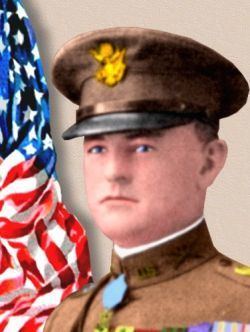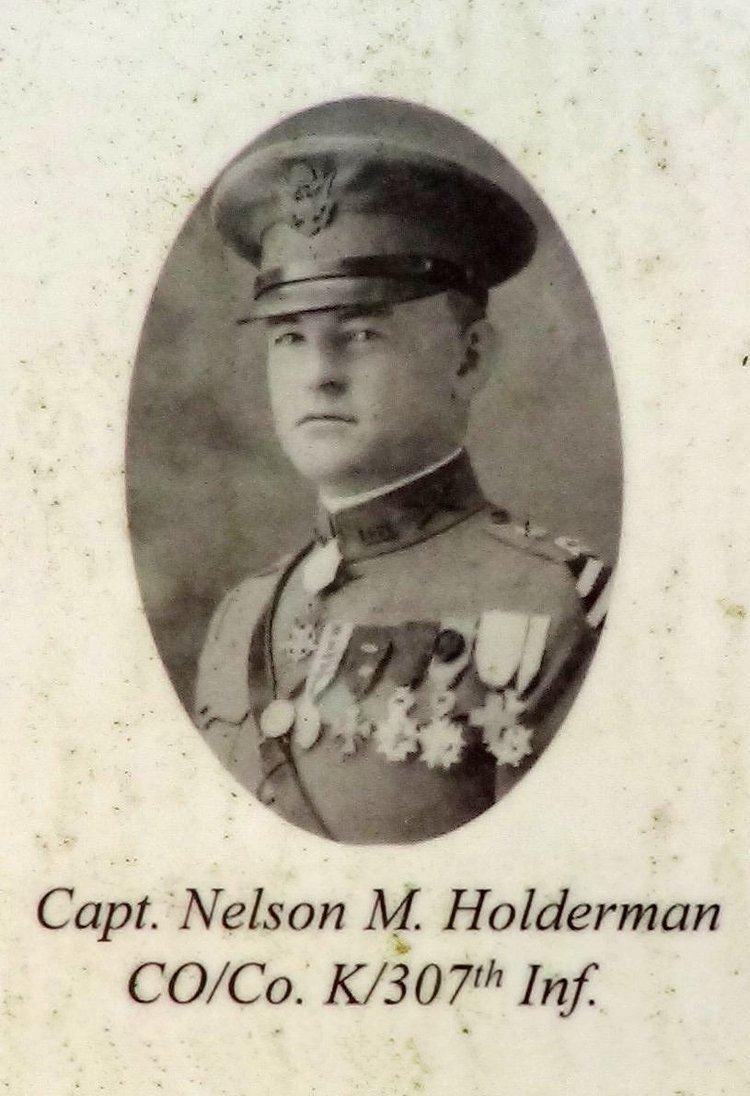Name Nelson Holderman | ||
 | ||
Died September 3, 1953, San Bruno, California, United States | ||
Colonel Nelson Miles Holderman (November 10, 1885 – September 3, 1953) was a United States Army officer, most notable for commanding a rifle company of the Lost Battalion during World War I for which he received the Medal of Honor. He was considered by many to be one of the most decorated American soldiers of the war.
Contents
- Biography
- Early military career
- World War I
- After World War I
- Medal of Honor citation
- Awards and recognitions
- Namesakes
- In popular culture
- References

Biography
Holderman was born in Trumbull, Nebraska, on 10 November 1885 and named Nelson Miles Holderman after a military officer that his father had served under who had been a hero in the American Civil War and a recipient of the Medal of Honor. He was the second oldest son in a family which included three older sisters and two brothers. In 1893, his family moved to Tustin, California, where his parents bought 30 acres (120,000 m2) of land to grow oranges, walnuts and apricots.
Early military career
In 1916, Holderman enlisted as a private in the Santa Ana unit of the California Army National Guard. From June to October of that year, he participated in patrols on the United States–Mexico border during the time of Pancho Villa's raids. Holderman quickly rose through the ranks and by the time of the American entry into World War I, which occurred on April 6, 1917, he was a captain, and a company commander in charge of Company L of his Santa Ana unit.
World War I
Upon arrival on the Western Front the following year his company was assigned as replacements for Company K of the 307th Infantry Regiment, part of the 77th Division of the American Expeditionary Force (AEF). Even though Holderman was a replacement officer for Company K, he was very well respected by the soldiers under his command due in part to his previous experience prior to the war. As an officer he was regarded as a "soldier's soldier" who never turned down a patrol and saw his military service as "an adventure".
His unit took part in the Meuse-Argonne Offensive in late September 1918. On October 3 a major offensive began whose purpose was to break the German line in the Argonne forest. Of all the units who took part in the initial assault, elements of two battalions under the command of Major Charles Whittlesey were able to break through. However, as the only units to have reached their objectives they had gone too far into German territory and were subsequently cut off. Initial attempts were made to reach Whittlesey and his men but all the units were met with heavy resistance and had to pull back. Only Holderman's Company K, composed of 97 men, had managed to reach Major Whittlesey's units which, incorrectly became known as "The Lost Battalion" even though there were two such units of that size. With not enough men able to close the distance between Whittlesey and the American lines, Holderman and his company subsequently became part of the Lost Battalion. Holderman was tasked to command the right flank. Though severely wounded early on in the five-day siege, Holderman continued to lead his men until finally being relieved. The war came to an end just over a month later, on November 11, 1918 at 11:00am.
After World War I
After the war, Holderman rejoined the National Guard and continued to serve for many years, eventually retiring with the rank of colonel. He was appointed as the commandant of the Veterans Home of California Yountville in Yountville, California taking caring of veterans. He served from 1923 until his retirement in 1953 during which time he greatly expanded the home. After his death, the Veterans Home was renamed to the Nelson M. Holderman in his honor. Though he was regarded as a national hero, he never used his status for personal gain.
Medal of Honor citation
Rank at time of receipt: Captain, U.S. Army. Unit: 307th Infantry Regiment, 77th Division. Place and date: Northeast of Binarville, in the forest of Argonne, France, 2-October 8, 1918. Entered service at: Santa Ana, California. Medal credited to: California. Authority: War Department General Order 11, 1921.
Citation:
Captain Holderman commanded a company of a battalion which was cut off and surrounded by the enemy. He was wounded on 4, 5, and 7 October, but throughout the entire period, suffering great pain and subjected to fire of every character, he continued personally to lead and encourage the officers and men under his command with unflinching courage and with distinguished success. On 6 October, in a wounded condition, he rushed through enemy machinegun and shell fire and carried 2 wounded men to a place of safety.
Awards and recognitions
Among Holderman's decorations and medals were the following:
Namesakes
The Captain Nelson M. Holderman U.S. Army Reserve Center in West Los Angeles, California is named in his honor, as is the main building on the grounds, Holderman Hall.
In popular culture
In the 2001 made-for-TV movie The Lost Battalion, Holderman was played by Adam James.
At the conclusion of the 1962 film The Manchurian Candidate, Frank Sinatra's character reads Holderman's and Daniel R. Edwards' Medal of Honor citations.
